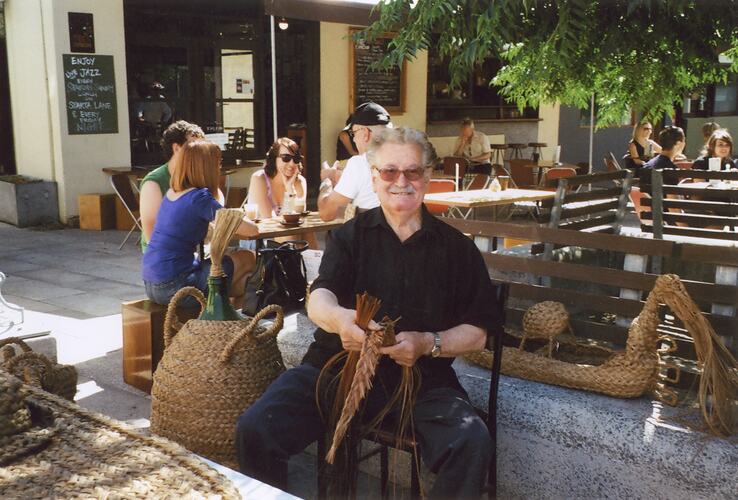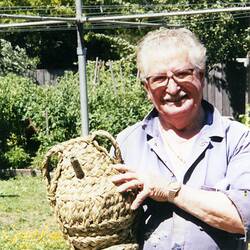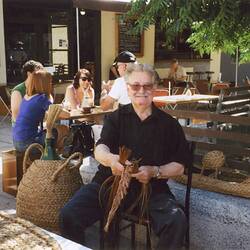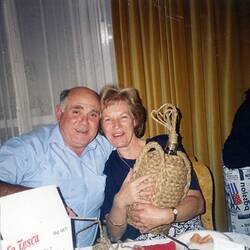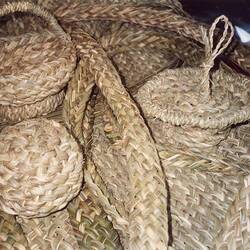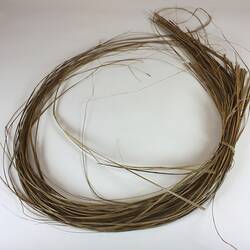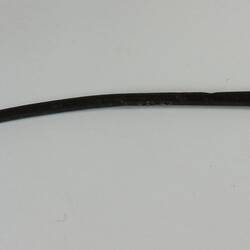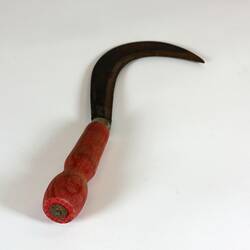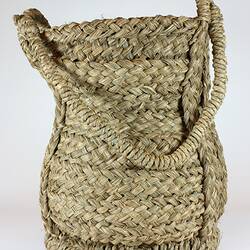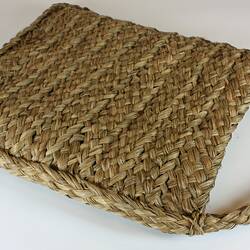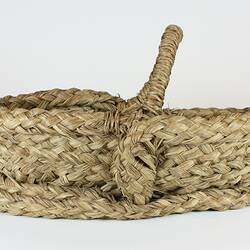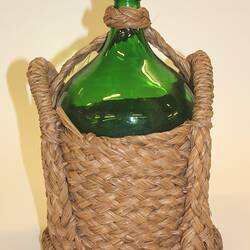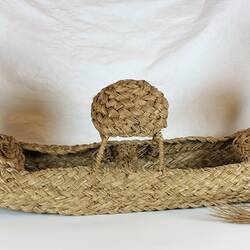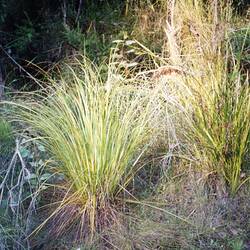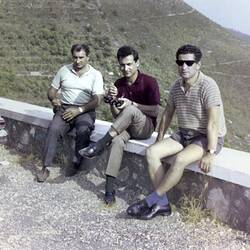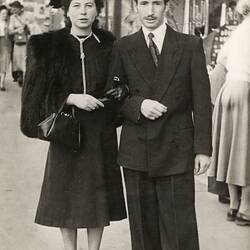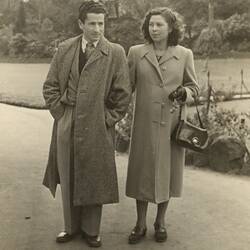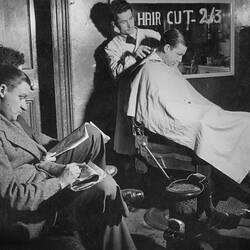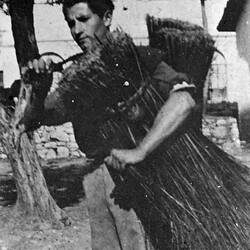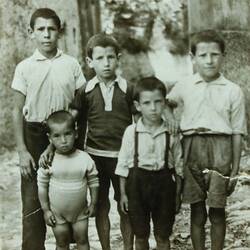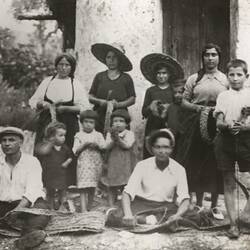Summary
Giovanni D'Aprano migrated with his mother and brothers from Ventosa, Italy in 1948, his wife Maria followed in 1949. A barber and fireman in Italy he also became an expert basket weaver like most people from his village. Giovanni settled in Pascoe Vale South in Melbourne, and undertook a law degree but has continued to pursue his passion for basket weaving throughout his life.
Migrating to Australia:
Giovanni (Gianni/John) Batista D'Aprano was born in Ventosa, a village in Lazio province between Rome and Naples in 1925. He was one of five brothers. A classic example of chain migration, his family commenced migrating to Melbourne in 1927 (an uncle), then another uncle in 1929, and another uncle and his son in 1937. Giovanni himself migrated on 26 May 1948, followed by his mother and two younger brothers. He had met Maria Assunta in Sabaudia in 1946 and they married and she followed him to Melbourne in 1949. The entire family had planned to leave Italy earlier but were prevented by the outbreak of World War II.
Wartime Hardship in Italy:
The War was an extremely difficult period for Giovanni and his family. Giovanni was a fireman in Castrovillari in Calabria province but was forced to flee and return to Ventosa. He and his brothers made bags at the directive of Mussolini's soldiers which were sent to Africa to be used as defensive sand bags for the Italian army. They worked constantly to meet the weekly quota which was collected by donkey-drawn cart every Saturday. After the War, the family, like much of the population in the south, were starving. After discovering a blade in the local river, Giovanni was able to produce bags and baskets which he sold through the local town hall. It kept his family alive and soon the whole town were carrying D'Aprano basket-woven bags.
Working Life in Melbourne:
Soon after arriving in Melbourne, Giovanni worked as a barber in a city salon in Elizabeth Street, and then opened his own shop in Sydney Road Brunswick. He had learned hair cutting as a child and practised in Italy. He and Maria had three children: Cosmo born 1949, John born 1955 and Tina born 1961. Cosmo and John would go on to become lawyers and Tina a university teacher.
First Home:
The couple built their first home in Pascoe Vale south which was to be their home throughout their lives. In 1958 Giovanni opened a real estate agency also in Sydney Road Brunswick with his two brothers. In 1974 Giovanni undertook a law degree at the University of Melbourne, became a Justice of the Peace and sat on the bench at the Brunswick Court, Pentridge Bail Office and worked for Melbourne University's legal advisory service.
Awards:
Giovanni has won a number of awards and certificates of appreciation from various community agencies, including the Victorian Government International Year of Volunteers (2001); Department of Justice, Justice of the Peace (2001); Royal Victorian Association Honorary Justices 30 Years Service (2009). He has displayed and demonstrated his basket weaving at a variety of Melbourne community events and venues, including the 'Weaving Lands' community arts project in Broadmeadows and the Immigration Museum (2002), Hume Global Learning Centre (2005), Museum of Lillydale (2005) and many schools.
Traditional Cultural Practices:
Giovanni and Maria continued many of their traditional Italian domestic traditions in Pascoe Vale South, including making their own tomato pasta sauce, olive oil, sausages and wine and Giovanni continues to cultivate a large number of olive and fig trees.
In 1971 Giovanni purchased a property in Noogee near Warburton where he had dairy cows, and grew chestnut trees. The property also had the reeds or 'strame' growing wild which he used for his basketweaving. Giovanni was about two years old when he first learnt the skill of basketweaving, it was a skill passed on to everyone in Ventosa, a village of around one thousand people at that time, and tradition dates it back to Olympia, one thousand years ago.
Giovanni continued to make baskets in Melbourne throughout his life, enjoying the practice and gave his creations to family and friends as gifts. The baskets, containers and sculptural pieces are all for primarily decorative purposes, although traditionally in Ventosa such items as baskets and bags had a very practical use. He found a variety of ways to apply his art such as by weaving seats on chair frames.
The technique requires the cutting of the 'strame' (reeds) with a small scythe and then laying it out to dry. The 'strame' are then pounded flat with a 'mazzucco' (a heavy wooden mallet), then dampened at which point the strands are ready to be woven. Giovanni brought with him from Italy a small scythe which he has continued to use to cut 'strame' and one of the larger needles he uses for the weaving had belonged to his grandfather, dating back to the 1850s. His 'mazzucco' he made in the 1970s from a branch from one of the chestnut trees he grew on his Nugee property. Giovanni is passionate about basket weaving but now believes he is the only practitioner of this particular regional style, both in Australia and in Italy.
Giovanni's Reflections:
'I come from a township of just 1000 people in Italy. It's called Ventosa. We are the only ones in the world that do this kind of basketmaking. For 2000 years it has been passed on from parents to children. Everyone in the township does this work - priests, chemists, shop keepers. Even two year old children will help. They learn by watching the adults. The children make simple pieces and the adults do more complicated work.
During the War, my township was made to work. Everyone had to make sandbags that were used to protect the guns that were fighting in Africa. Now I am the only one left who still has this skill. I would give my right arm if someone would take over and learn what I do. But you must be born with it. It's like an art.' [from 'the Making of the Galgi-ngarrak Yirranboi Tree' exhibition pamphlet, Hume Global Learning Centre Broadmeadows and Immigration Museum Melbourne, 2004]
More Information
-
Keywords
-
Authors
-
Article types
